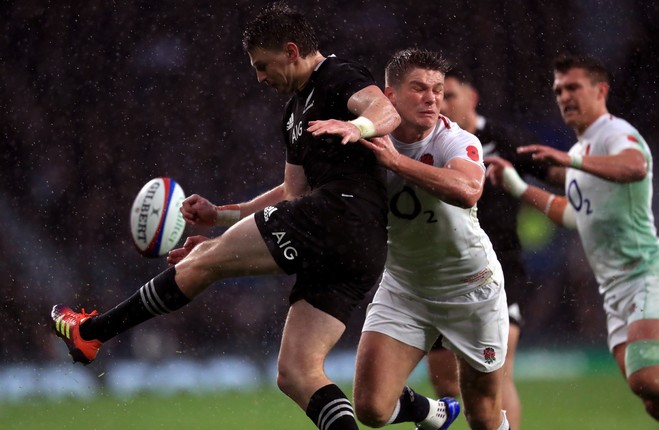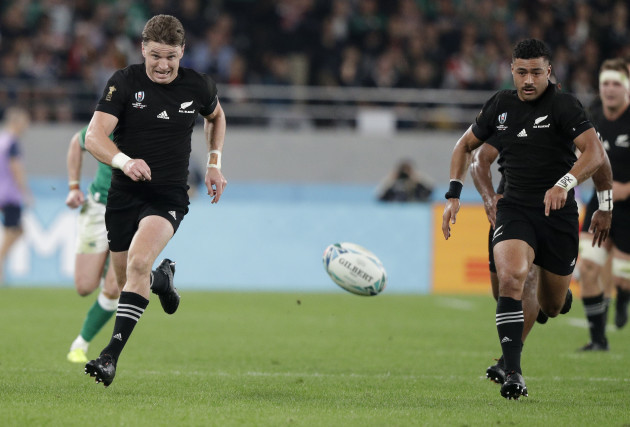IT IS AN interesting note in the development of both England and New Zealand over the last 12 months that neither of the world’s two premier out-halves will have the No 10 on their back in Yokohama on Saturday.
That says as much about the quality available to England and New Zealand as it does the cunning of both Eddie Jones and Steve Hansen.
It is been a curious tournament for both Owen Farrell and Beauden Barrett, two players who have made their name at out-half yet line out this weekend in slightly less familiar surroundings.
Both are very different players, with their opposing styles evident in last year’s meeting at Twickenham, where New Zealand won a dogged match 16-15. The more industrious Farrell made four runs for six metres, compared to the 19 runs and 37 metres made by Barrett. Without the ball, Farrell made more than twice the amount of tackles as Barrett.
England captain Farrell has been nowhere near as influential as usual when shifted into midfield during this World Cup. He was quiet against Tonga, started on the bench against the United States and was physical, yet off-colour, against Argentina.
It was clear that England were not getting the most out of their leader, although routine wins against Tonga and Argentina were never going to make or break Jones’ thinking. The issue was also eased by the fact that Jones’ preferred out-half during the pool stages, George Ford, had been one of England’s best players.
Jones reverted to old ways for the quarter-final against Australia by restoring Farrell to out-half, and the Saracens player responded with easily his best performance of the World Cup to date. In the 40-16 defeat of the Wallabies Farrell was a menace in attack, producing a wonderful try assist while chipping in with his usual aggressive defensive effort. He made seven more tackles (17) than the nearest Australia player.
So why is he back at centre for the biggest game of Jones’ spell as England boss?
For a start Farrell’s impact during the last Lions Tour wouldn’t have been lost on Jones. In 2017 Farrell started the first Test against the All Blacks at out-half, with Johnny Sexton on the bench as the tourists lost 30-15. Farrell’s influence was restricted by the All Blacks excellent linespeed as a tame looking Lions team were trampled in Auckland.
For the second and third Tests, Lions head coach Warren Gatland opted for Sexton as his No 10 with Farrell relocated to inside centre. The two combined wonderfully as the Lions levelled the series with a win and a draw.
Farrell is a ferocious player in defence, and although his tackle technique has come under heavy criticism Jones clearly feels he is best served by adding his steel to the midfield this weekend. He will still stand over the place kicks, and will still kick in behind the New Zealand defence if he senses opportunity. Should England advance into the final he may move Farrell around again. It would not be surprising to see him back in the driving seat if the opponent was Wales, while remaining at centre to provide that defensive security if England were to face the hugely physical Springboks.
Barrett’s switch of position has been much more definite, and thrown up less questions.
For the bulk of the last three years leading into this World Cup, Barrett was New Zealand’s first-choice out-half, and there were few complaints. The Hurricanes man, who will join the Blues next year, was named World Rugby Player of the Year in 2016 and 2017, with Farrell nominated at out-half on both occasions.
And while Barrett was universally viewed as the best No 10 around, before losing that crown – officially at least – to Sexton last year, there were a few question marks surrounding his game. He needed to work harder on the game management side of things compared to players like Farrell and Sexton, while crucially, his place-kicking was not as reliable as many of his peers.
It wasn’t until July of this year that Hansen pushed him back down the pitch, a bold move considering the World Cup was only a couple of months away, with Richie Mo’unga instead coming in at out-half during the Rugby Championship. At the time Mo’unga had only made two starts for the All Backs and although he took a few games to settle, New Zealand have reaped the benefits of Hansen’s new arrangement in Japan.
The motive behind Hansen’s thinking was clear, with New Zealand no strangers to adopting the dual play-maker approach down the years. The New Zealand head coach felt the need to fine-tune his side to be better prepared for dealing with rush defences following a handful of defeats and near-misses, and by having both Mo’unga and Barrett in his team he now has two devastating play-makers to keep the opposition occupied, while he also has the more reliable boot of Mo’unga on the pitch. The combination has worked so well that only injury would disrupt their selection should New Zealand advance to the final.
The ACL injury sustained by Damian McKenzie earlier this year also increased Hansen’s need for a high-quality full-back. McKenzie had started 14 games at full-back between August 2017 and the end of the All Blacks’ 2018 season.
In the mark of a true world class talent, Barrett has proved just as effective in his new home. While the 28-year-old was well-accustomed to seeing out the final stages of games at full-back, he had only started a handful of games in the position across his seven year international career.
That was the big difference between his situation and that of England’s Farrell. Between 2015-18, Farrell played the majority of his intentional rugby at centre, before Eddie Jones appeared to settle on him as his starting out-half. Farrell started all five of England’s Six Nations games this year at out-half.
Like Hansen with Barrett, Jones feels his best out-half can be just as dangerous elsewhere on the pitch, even if he didn’t quite hit the expected heights during those rather flat pool stage affairs. Their new homes haven’t changed the fact that both players still make their teams tick, and still have the ability to change a game by themselves.
By moving their top out-halves out of position, Jones and Hansen may have uncovered the best of both worlds.


